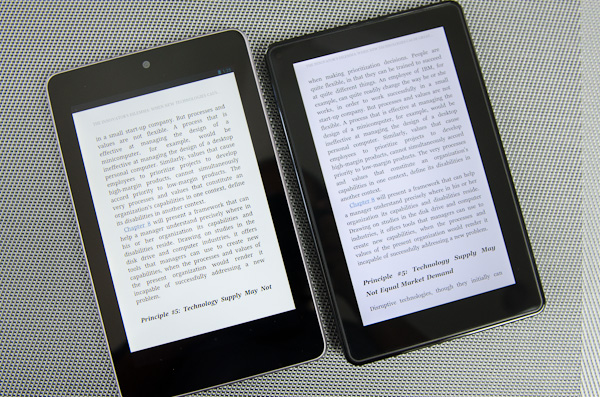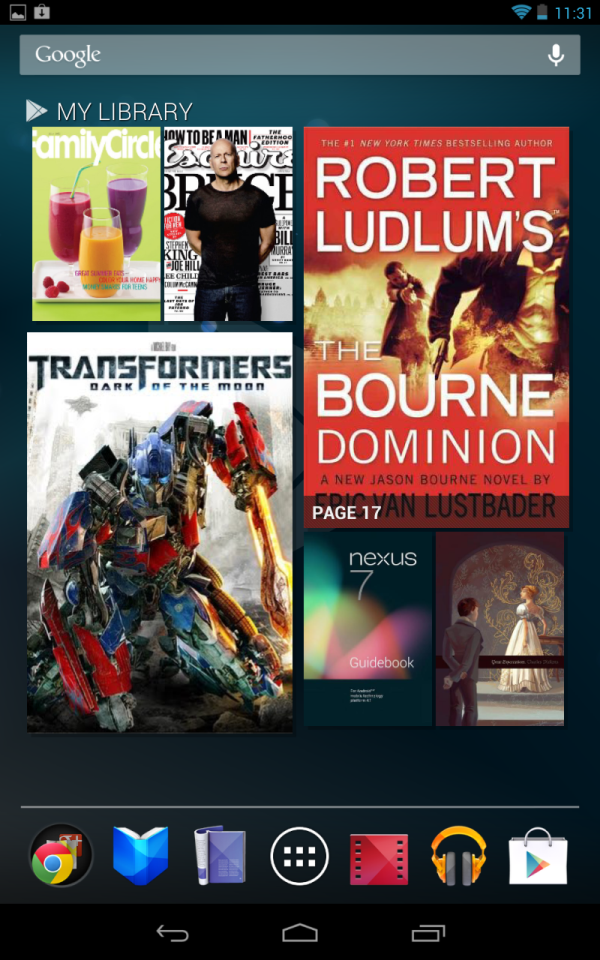The Google Nexus 7 Review
by Anand Lal Shimpi & Brian Klug on July 26, 2012 11:35 AM ESTAndroid 4.1
In the process of working on the Nexus 7 review I dusted off (literally) my Kindle Fire, powered it up and checked for updates expecting to find tons. I found none. The Kindle Fire is still running 6.3.1, released a few months ago, and more importantly it's still relying on the CPU for a lot of drawing, which means the UI isn't smooth. Scrolling in Amazon's Silk Browser is fast, but only because the Kindle Fire drops a lot of animation frames. The experience is jarring, and much better on the Nexus 7 by comparison.
While the Kindle Fire's OS looks like a polished, previous generation of Android, Android 4.1 delivers much of the smoothness of the iPad's iOS. Don't get me wrong, there are still some rough edges and hiccups. Project butter or not, Android 4.1's UI performance is still not perfect, but it's nearly so, and it's miles better than the Kindle Fire.

Nexus 7 running Kindle for Android (left) vs. Kindle Fire (right)
The Kindle Fire's carousel of previously used apps and media is smooth, but browsing the web on it is a mess compared to the Nexus 7. What's even more embarrassing for the Fire is even the Kindle app on the Nexus 7 delivers a smoother experience. Couple that with a warmer display and you actually have a better Kindle in the Nexus 7 than with Amazon's own device. When the Kindle Fire was released, its imperfections were easily overlooked since the Fire was so much better than any prior $199 tablets. The Nexus 7 dramatically raised the bar in the experience department.
Even compared to the Transformer Pad Infinity, the Nexus 7 feels faster thanks to UI speed improvements in Jelly Bean. The entire OS feels snappier, despite running on technically slower hardware.
What sets a tablet apart from a smartphone isn't just physical size, but also applications that take advantage of the size/resolution. Google attempts to deliver this with giant widgets that serve as portals to your content. The My Library widget automatically populates itself with books, magazines and movies you've purchased from the Google Play store. The result is quite impressive:
Start adding more conventional shortcuts to your home screen and the illusion quickly collapses, but I do believe the well laid out main home screen is what Google originally intended with widgets on Android.
As an eReader I'd argue the Nexus 7 is at least as good as the Kindle Fire. You can debate the pros/cons of books from Google Play vs. Amazon's Kindle store, but the fact is that both are available on the Nexus 7. The Kindle app for Android works well (as I've already mentioned), although for actual shopping you'll have to use Amazon's website. A small price to pay for a much better tablet experience everywhere else.
In all honesty, that's what you really give up when picking the Nexus 7 over the Kindle Fire - you lose the tightly integrated Amazon shopping experience. You also lose Amazon's video streaming service, which presently doesn't have an Android client.











118 Comments
View All Comments
Sprchkn - Thursday, July 26, 2012 - link
Except that Flash isn't supported on Jelly Bean... I know, mine arrived yesterday and I tried that. Amazon either needs to release an Android app or move to HTML5.But, I've already cancelled the auto-renewal on my Prime account due to their use of Flash DRM which requires a workaround to install the deprecated HAL package under Gentoo so it's not like I'm married to them. Google actually seems to be the only one that supports both Linux and Android, so I'll just start purchasing my video content from them.
Impulses - Friday, July 27, 2012 - link
Flash works fine on Jelly Bean under Firefox and other browsers, just need to side load it.RamarC - Thursday, July 26, 2012 - link
will allow usb tthumb drive/sd cards to be used with the Nexus 7.WolvenSpectre - Thursday, November 8, 2012 - link
The problem is that it doesn't give you any write capability.Pino - Thursday, July 26, 2012 - link
"213 pixels per inch in a 7 inch display is unique for an Android tablet"Lenovo´s S2007 tablet has such a display and was launched way before the Nexus 7:
http://appserver.lenovo.com.cn/Lenovo_lepadSeries_...
eaanders@cox.net - Thursday, July 26, 2012 - link
The primary advantage of the Nexus 7 is price. If a tablet is so small you need to zoom, the sweet spot is the Galaxy Note. It's half the weight of the 7, fits in your shirt pocket, and combines the features of a phone, a camera, and a small tablet in one unit with the possibility of adding an additional 32 Gb of storage. The Note 2 will be even faster.My netbook will be replaced by a Windows 8 hybrid eventually for full computing power. This and the Galaxy Note are all I will need to do everything mobile.
Sprchkn - Thursday, July 26, 2012 - link
I think it depends on what you're using it for. I bought the Nexus 7 so that I can leave my phone docked up to my stereo and then look up recipes, check email, etc. while I'm in the kitchen cooking. The speakers are a bit weak, but it will probably also see some duty playing movies, again, while I'm cooking or perhaps when I'm on my treadmill. The missing storage hasn't been a problem for me with the way I use my phone and I always have my iPod available for music duty. Besides, for whatever reason, I've always had trouble with the micro SDs and corruption when copying large amounts of data onto them - so I'm actually relieved that Google Play means I no longer have to deal with that.MadMan007 - Thursday, July 26, 2012 - link
An unlocked Galaxy Note is over twice as expensive as the Nexus 7. It's only fair to compare unsubsidized vs unsubsidized pricing. Everyone's needs and wants are different, but the 'if you're going to zoom anyway' point is valid if one were going to get a subsidized phone anyway and can deal with the size of the Note as a phone.hackbod - Thursday, July 26, 2012 - link
Great stuff on the NAND performance, as well as the commentary on the screen configuration. Your reviews are consistently the most detailed and technically accurate I see.One thing that would be interesting to do is NAND performance comparisons with the 16GB model. I believe this uses a different NAND controller, so you should see some different interesting behavior. And since the 16GB model is likely more popular than the 8GB one, this would be relevant to many people.
risa2000 - Friday, July 27, 2012 - link
I would like to see similar tests (flash throughput) done also with smartphones. There has been rumors that there are some significant difference between some (e.g. iPhone and some Androids) and it would be interesting to know also for new WP devices.